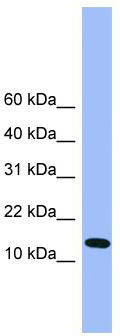ATP5F1D Rabbit Polyclonal Antibody
Other products for "ATP5F1D"
Specifications
| Product Data | |
| Applications | WB |
| Recommended Dilution | WB |
| Reactivities | Mouse |
| Host | Rabbit |
| Isotype | IgG |
| Clonality | Polyclonal |
| Immunogen | The immunogen for anti-Atp5d antibody: synthetic peptide corresponding to a region of Mouse. Synthetic peptide located within the following region: SVQLLAEEAVTLDMLDLGAARANLEKAQSELSGAADEAARAEIQIRIEAN |
| Formulation | Liquid. Purified antibody supplied in 1x PBS buffer with 0.09% (w/v) sodium azide and 2% sucrose. Note that this product is shipped as lyophilized powder to China customers. |
| Purification | Affinity Purified |
| Conjugation | Unconjugated |
| Storage | Store at -20°C as received. |
| Stability | Stable for 12 months from date of receipt. |
| Predicted Protein Size | 18 kDa |
| Gene Name | ATP synthase, H+ transporting, mitochondrial F1 complex, delta subunit |
| Database Link | |
| Background | Mitochondrial membrane ATP synthase (F1F0 ATP synthase or Complex V) produces ATP from ADP in the presence of a proton gradient across the membrane which is generated by electron transport complexes of the respiratory chain. F-type ATPases consist of two structural domains, F1 - containing the extramembraneous catalytic core, and F0 - containing the membrane proton channel, linked together by a central stalk and a peripheral stalk. During catalysis, ATP turnover in the catalytic domain of F1 is coupled via a rotary mechanism of the central stalk subunits to proton translocation. Part of the complex F1 domain and of the central stalk which is part of the complex rotary element. Rotation of the central stalk against the surrounding alpha3beta3 subunits leads to hydrolysis of ATP in three separate catalytic sites on the beta subunits. |
| Synonyms | ATP synthase; delta subunit; H+ transporting; mitochondrial ATP synthase; mitochondrial ATP synthase complex delta-subunit precusor; mitochondrial F1 complex |
| Note | Immunogen Sequence Homology: Human: 100%; Bovine: 100%; Dog: 93%; Pig: 93%; Rat: 93%; Horse: 93%; Mouse: 93%; Guinea pig: 93%; Zebrafish: 79% |
| Reference Data | |
| Protein Pathways | Alzheimer's disease, Huntington's disease, Metabolic pathways, Oxidative phosphorylation, Parkinson's disease |
Documents
| Product Manuals |
| FAQs |
{0} Product Review(s)
0 Product Review(s)
Submit review
Be the first one to submit a review
Product Citations
*Delivery time may vary from web posted schedule. Occasional delays may occur due to unforeseen
complexities in the preparation of your product. International customers may expect an additional 1-2 weeks
in shipping.






























































































































































































































































 Germany
Germany
 Japan
Japan
 United Kingdom
United Kingdom
 China
China



